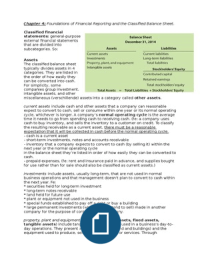Chapter 4: Foundations of Financial Reporting and the Classified Balance Sheet.
Classified financial
statements: general-purpose
external financial statements
that are divided into
subcategories. So:
Assets
The classified balance sheet
typically divides assets in 4
categories. They are listed in
the order of how easily they
can be converted into cash.
For simplicity, some
companies group investment,
intangible assets, and other
miscellaneous (verschillende) assets into a category called other assets.
current assets include cash and other assets that a company can reasonable
expect to convert to cash, sell or consume within one year or its normal operating
cycle, whichever is longer. A company’s normal operating cycle is the average
time it needs to go from spending cash to receiving cash. (fe: a company uses
cash to buy inventory, and sells the inventory to a customer on credit. To classify
the resulting receivable as a current asset, there must be a reasonable
expectation that it will be collected in cash before the normal operating cycle.
- cash is a current asset
- short-term investments, notes and accounts receivable
- inventory that a company expects to convert to cash (by selling it) within the
next year or the normal operating cycle
In the balance sheet they’re listed in order of how easily they can be converted to
cash.
- prepaid expenses, (fe: rent and insurance paid in advance, and supplies bought
for use rather than for sale should also be classified as current assets.)
investments include assets, usually long-term, that are not used in normal
business operations and that management doesn’t plan to convert to cash within
the next year. Fe:
* securities held for long-term investment
* long-term notes receivable
* land held for future use
* plant or equipment not used in the business
* special funds established to pay off a debt or buy a building
* large permanent investments (which aren’t intend to sell) made in another
company for the purpose of controlling that company.
property, plant and equipment (called operating assets, fixed assets,
tangible assets) include tangible long-term assets used in a business’s day-to-
day operations. They present a place to operate (land and buildings) and the
equipment used to produce, sell and deliver goods or services. Through
, depreciation, the costs of these assets (except the cost of land) are spread over
the periods they benefit. Past depreciation is recorded in the Accumulated
Depreciation Accounts and deducted from their related asset accounts on the
balance sheet. Often used as a clutter (verzamelnaam), all together on one
account.
- also includes natural resources owned by the company (fe: forest lands, oil and
gas properties, coal mines) If they are all used in the regular course of business
-> If they’re not they’re listed in the investment category.
intangible assets long-term assets with no physical substance (inhoudt). Their
value stems (komt voort) from the rights or privileges accruing (toekomen aan) to
their owners. (fe: patents, copyrights, franchises and trademarks.)
- these assets are recorded at cost, which is spread over the expected life of the
right or privilege.
- goodwill: which arises in an acquisition (overname) of another company, is
another intangible asset that is recorded at cost -> but the cost isn’t located
(amortized) (afgeschreven) over the future periods. It is reviewed each year for
possible loss of value, or impairment (bijzondere waardevermindering)
Liabilities
Divided into 2 categories: Current liabilities and long-term liabilities
current liabilities are obligations that must be satisfied within one year of within
the company’s normal operating cycle, whichever is longer.
- typically paid out of current assets or by incurring new short-term liabilities.
fe: - notes payable
- accounts payable
- the current portion of long-term debt
- salaries and wages payable
- customer advances (unearned revenues)
Long-term liabilities are debts (schulden) that fall due (verschuldigd) more than
one year in the future or beyond the normal operating cycle -> thus, will be paid
out of noncurrent assets. Fe:
- mortgage pauable
- long-term notes
- bonds payable
- employee pension obligations
- long-term lease liabilities
Stockholders’ equity
Although the form of the business organization doesn’t usually affect the
accounting treatment of assets and liabilities, the equity section of the balance
sheet DOES differs depending on whether the business is a sole proprietorship, a
partnership or a corporation.
sole proprietorship
- terms as owner’s equity, proprietorship, owner’s capital and net worth
are used to refer to the owner’s interest, or equity (eigen vermogen), in a
company.
- the owner’s equity section of a sole proprietorship might appear as follows:





